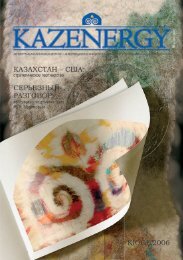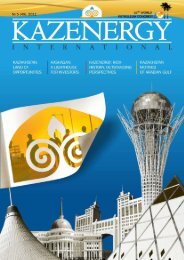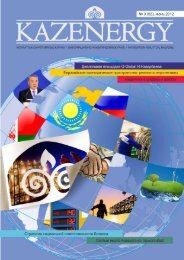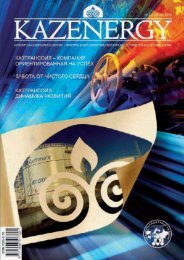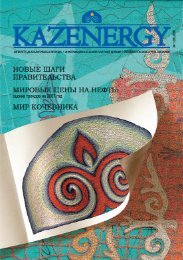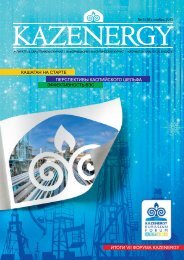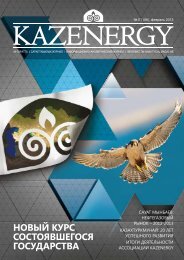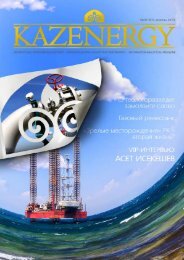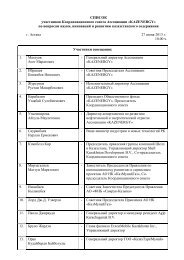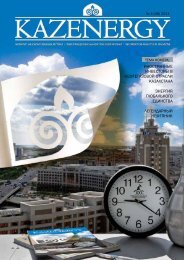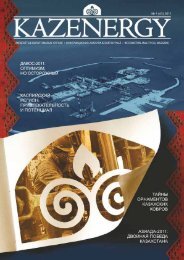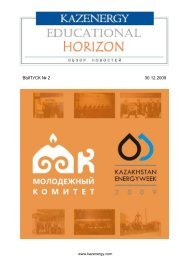KAZAKHSTAN UPSTREAM OIL AND GAS technology and R&d ...
KAZAKHSTAN UPSTREAM OIL AND GAS technology and R&d ...
KAZAKHSTAN UPSTREAM OIL AND GAS technology and R&d ...
Create successful ePaper yourself
Turn your PDF publications into a flip-book with our unique Google optimized e-Paper software.
1.1 Seismic data acquisition <strong>and</strong> processing<br />
Challenge commentary<br />
The challenge for Kazakhstan in this area is<br />
simple: operators need better seismic images<br />
of the complex reservoirs that make up the<br />
bulk of the nation’s reserves.<br />
Most reservoirs in Kazakhstan are in<br />
relatively complex carbonate formations<br />
that are overlaid by salt. Consequently,<br />
seismic image quality is a major issue both<br />
onshore <strong>and</strong> offshore. Kazakhstan’s biggest<br />
field, Kashagan, is a classic case in point.<br />
The problem is made worse at Kashagan,<br />
as modern high-density <strong>and</strong> wide-azimuth<br />
streamer <strong>technology</strong> does not work well<br />
in shallow water. Poor seismic quality is<br />
also observed in clastic reservoirs lying<br />
beneath carbonate formations; fields such<br />
as Karachaganak <strong>and</strong> Pearls are known<br />
to have this problem. Elimination of water<br />
bottom multiples is another issue: these<br />
degrade image quality <strong>and</strong> hamper the use of<br />
advanced data processing techniques.<br />
Underst<strong>and</strong>ing the heterogeneity common in<br />
carbonate reservoirs is a particular challenge.<br />
Tengiz <strong>and</strong> Chinarevskoe, for example, both<br />
have adjacent units with quite different porosity<br />
<strong>and</strong> permeability. Determining the distribution<br />
of these properties is vital to optimising<br />
hydrocarbon recovery; it requires seismic data<br />
with higher lateral <strong>and</strong> vertical resolution<br />
than is normally achieved in Kazakhstan.<br />
The design <strong>and</strong> acquisition of 4D seismic<br />
is the other challenge in this <strong>technology</strong><br />
area. This is not well established in<br />
Kazakhstan. An improved capability would<br />
be of significant benefit, especially in terms<br />
of better underst<strong>and</strong>ing the performance<br />
of waterflooding operations <strong>and</strong> the<br />
identification of str<strong>and</strong>ed or bypassed zones.<br />
VALUE<br />
CHALLENGE (elements)<br />
Seismic imaging sub-salt &<br />
in carbonates<br />
1.1.4<br />
1.1.7<br />
1.1.2<br />
1.1.5<br />
1.1.1<br />
1.1.3<br />
1.1.6<br />
TECHNOLOGY SOLUTIONS<br />
1.1.1 Seismic acquisition for shallow waters<br />
1.1.2 Seismic acquisition for enhanced imaging<br />
1.1.5 Seismic processing for improving imaging<br />
1.1.1 Seismic acquisition for shallow waters<br />
1.1.2 Seismic acquisition for enhanced imaging<br />
1.1.3 Non-seismic solutions for reservoir evaluation<br />
1.1.5 Seismic processing for improving imaging<br />
1.1.6 Integration of seismic & other data<br />
1.1.7 Advanced seismic inversion<br />
ATTRACTIVENESS<br />
37<br />
Seismic resolution to determine<br />
reservoir characteristics<br />
Design & acquisition of<br />
time-lapse (4D) seismic<br />
1.1.1 Seismic acquisition for shallow waters<br />
1.1.2 Seismic acquisition for enhanced imaging<br />
1.1.4 4D seismic<br />
Kazakhstan Upstream oil & gas <strong>technology</strong> <strong>and</strong> R&D roadmap




